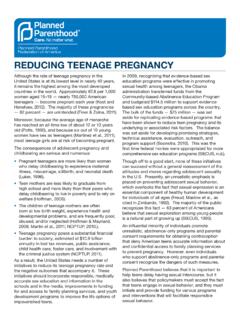Transcription of Caseload and Workload Management - Child Welfare
1 ISSUE BRIEF. July 2016. Caseload and Workload WHAT'S INSIDE. Management Background Large caseloads and excessive workloads in many Benefits of reasonable caseloads and jurisdictions can make it difficult for Child Welfare manageable workloads caseworkers (workers) to serve families effectively. Administrative requirements for each case are on the Catalysts and rise, and complex cases require intensive interventions, motivating factors for which further add to caseworker workloads. Manageable reducing caseloads and workloads caseloads and workloads can make a real difference in a worker's ability to engage families, deliver Assessing caseloads quality services, stay with the agency, and ultimately and workloads achieve positive outcomes for children and families.
2 Strategies for Caseload Reducing and managing caseloads and workloads and Workload Management are not simple tasks for Child Welfare administrators. Agencies face a number of challenges, including State examples negotiating budget crises and hiring freezes, addressing of Caseload and worker turnover, finding qualified applicants for open Workload strategies positions, implementing time-intensive best practices, and managing multiple reforms simultaneously Conclusion (Munson, McCarthy, & Dickinson, 2014). It can even Additional resources be difficult to just determine what the Caseload and Workload levels currently are and what they should be.
3 References Children's Bureau/ACYF/ACF/HHS. | Email: | Caseload and Workload Management Nevertheless, agencies are addressing these (Owens, 2015). The Department of Human Services planned challenges and successfully implementing a variety to hire additional workers to handle the surge. Additionally, of strategies to make caseloads and workloads workers are increasingly expected to do more assessments, more manageable. This issue brief aims to build the searches, notifications, visits, team meetings, plans, knowledge base about Caseload and Workload issues referrals, court testimonies, and documentation.
4 Although and help State Child Welfare managers, administrators, the heightened expectations may be necessary to provide and others learn how they can improve Caseload quality services, they can make for excessive workloads and Workload situations in their agencies. even when caseloads do not exceed agency standards. Although specific results vary by agency, there are some Definitions common findings about Caseload and Workload in the Child Welfare literature (American Humane Association Caseload : The number of cases (children or [AHA], 2000; Deloitte Consulting, 2015; Hornby Zeller families) assigned to an individual worker in a Associates [HZA], 2006; HZA, 2009; ICF International given time period.)
5 Caseload reflects a ratio of & Walter R. McDonald & Associates, 2014; McKinsey &. cases (or clients) to staff members and may be Company, 2008; Walter R. McDonald & Associates & AHA, measured for an individual worker, all workers 2006; Walter R. McDonald & Associates & AHA, 2007): assigned to a specific type of case, or all workers in a specified area ( , agency or region). Available time. Workers tend to spend 60 to 70. percent of their work time on case-related activities, Workload : The amount of work required with approximately 20 to 35 percent on direct client to successfully manage assigned cases and contact or collateral contact ( , individuals, such as bring them to resolution.
6 Workload reflects the referral source or professionals in the community, the average time it takes a worker to (1) do the who can provide additional information). The remaining work required for each assigned case and (2) non-case-related time is spent on training, leave, and complete other non-casework responsibilities. administrative tasks ( , supervisory or unit meetings not related to a case, task forces or committees, community outreach, and/or reviewing policies). Background Variability in Workload demands.
7 Workload varies by a number of case characteristics, such as where High caseloads and workloads can stem from a variety the Child resides ( , in his/her home, relative home, of circumstances. Increased caseloads can be attributed foster home, or congregate care), the number of to rises in the incidence of maltreatment ( , as a result children involved, the phase of the case process ( , of escalations in substance use), increases in reporting intake, assessment, investigation, permanency), court ( , due to increased public awareness)
8 , changes involvement, permanency goals, task types ( , face- to intake or case decision criteria ( , thresholds to-face contact, service planning, team meetings, and/. for opening cases for services), or the expansion of or documentation), and the complexity of the case. It services ( , extended foster care for older youth). also is affected by the worker's Caseload . Workload also varies by agency characteristics such as location ( , Increases in the amount of work required for each case urban , rural, remote), number of staff, and number of may also be caused by changes to laws and policies or support staff.
9 These data can help establish standards other accountability requirements. For example, Child for Caseload sizes or to weigh cases when calculating a maltreatment hotline staff in Pennsylvania experienced worker's current Caseload . an unexpectedly high call volume in 2015 after State laws expanded the definition of who is a mandated reporter This material may be freely reproduced and distributed. However, when doing so, please credit Child Welfare Information Gateway. This publication is available online at 2.
10 Caseload and Workload Management Benefits of Reasonable Caseloads leave ( , Bowling, Alarcon, Bragg, & Hartman, 2015;. Kim & Kao, 2014). Manageable workloads may help and Manageable Workloads agencies retain workers who would otherwise opt to Caseload and Workload Management often appear leave as a result of feeling overloaded. as key ingredients in a State's comprehensive Supporting worker attitudes and well-being. strategy to produce better outcomes for children Workers' perceptions of their workloads are related and families.











